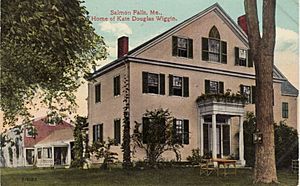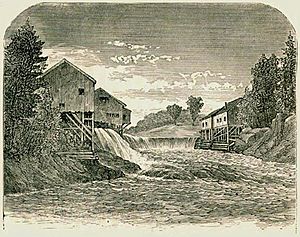Hollis, Maine facts for kids
Quick facts for kids
Hollis, Maine
|
|
|---|---|

Quillcote, c. 1916
|
|
| Country | United States |
| State | Maine |
| County | York |
| Incorporated | 1798 |
| Government | |
| • Type | Town meeting |
| Area | |
| • Total | 32.99 sq mi (85.44 km2) |
| • Land | 32.01 sq mi (82.91 km2) |
| • Water | 0.98 sq mi (2.54 km2) |
| Elevation | 203 ft (62 m) |
| Population
(2020)
|
|
| • Total | 4,745 |
| • Density | 148/sq mi (57.2/km2) |
| Time zone | UTC-5 (Eastern (EST)) |
| • Summer (DST) | UTC-4 (EDT) |
| Area code(s) | 207 |
| FIPS code | 23-33665 |
| GNIS feature ID | 0582523 |
| Website | hollismaine.org |
Hollis is a town located in York County, Maine, in the United States. In 2020, about 4,745 people lived there. Hollis is a quiet, rural town where many people live but travel to nearby cities for work. It is part of the larger Portland metropolitan area.
Contents
History of Hollis
Early Days and Native Americans
The area now known as Hollis was first called Little Falls Plantation. It also included parts of what are now Dayton and Limington. In 1664, a man named Major William Phillips bought the land. He bought it from Hobinowell and Mogg Hegon, who were sagamores (leaders) of the local Abenaki Native American tribes.
In 1728, the government of Massachusetts decided to build a special building. It was a trading post and a stockaded blockhouse on the Saco River. This building was used for trading with Native Americans. It was made of logs and had a cannon. Ten men and a sergeant guarded it.
Settlement and Naming
In 1754, John and Andrew Gordon tried to settle here. However, Native Americans drove them away. The first official meeting of the plantation happened on March 27, 1781. Joseph Chadbourne was chosen to lead the meeting. By 1790, the population had grown to 607 people.
In 1798, Little Falls became an official town. It was named Phillipsburg, after Major Phillips. The very first town meeting for Phillipsburg was held on September 27, 1798. In 1810, a group decided to change the town's name. They chose the name Hollis. No one knows for sure why they picked this name. It might have been inspired by Hollis, New Hampshire, or by the Duke of Newcastle, whose family name was Holles.
Farming and Industry
Farmers in Hollis grew crops like corn, potatoes, and hay. The Saco River was important because its water power ran many mills. These mills were in different parts of town, like Hollis village and Bar Mills. They included lumber mills, a factory for spools, and a wooden box factory. There was also a company that made woolen goods. The Portland and Rochester Railroad also passed through the southern part of the town.
Recent Events
On October 16, 2012, Hollis was very close to where a 4.0 magnitude earthquake happened. Many people across New England felt this earthquake.
Geography of Hollis
Hollis covers about 32.99 square miles (85.44 square kilometers). Most of this area is land, and a small part is water. Cook's Brook and the Saco River flow through Hollis.
Hollis shares its borders with several other towns. To the north are Limington and Standish. To the east is Buxton. To the south is Dayton. To the southwest is Lyman, and to the west is Waterboro.
Climate in Hollis
Hollis has a humid continental climate. This means it has cold, snowy winters. Summers are usually mild to warm, and it rains often.
| Climate data for Hollis, Maine, 1991–2020 normals, extremes 1994–present | |||||||||||||
|---|---|---|---|---|---|---|---|---|---|---|---|---|---|
| Month | Jan | Feb | Mar | Apr | May | Jun | Jul | Aug | Sep | Oct | Nov | Dec | Year |
| Record high °F (°C) | 65 (18) |
67 (19) |
85 (29) |
93 (34) |
94 (34) |
96 (36) |
98 (37) |
98 (37) |
94 (34) |
85 (29) |
74 (23) |
70 (21) |
98 (37) |
| Mean maximum °F (°C) | 50.9 (10.5) |
51.9 (11.1) |
60.9 (16.1) |
78.1 (25.6) |
88.7 (31.5) |
90.2 (32.3) |
91.8 (33.2) |
89.6 (32.0) |
86.3 (30.2) |
74.5 (23.6) |
65.1 (18.4) |
53.9 (12.2) |
94.1 (34.5) |
| Mean daily maximum °F (°C) | 29.4 (−1.4) |
32.6 (0.3) |
40.8 (4.9) |
53.8 (12.1) |
66.0 (18.9) |
75.0 (23.9) |
80.3 (26.8) |
78.8 (26.0) |
70.6 (21.4) |
57.8 (14.3) |
45.7 (7.6) |
34.9 (1.6) |
55.5 (13.0) |
| Daily mean °F (°C) | 18.6 (−7.4) |
20.8 (−6.2) |
29.8 (−1.2) |
41.7 (5.4) |
53.3 (11.8) |
62.8 (17.1) |
68.4 (20.2) |
66.5 (19.2) |
58.2 (14.6) |
46.4 (8.0) |
35.7 (2.1) |
25.4 (−3.7) |
44.0 (6.7) |
| Mean daily minimum °F (°C) | 7.8 (−13.4) |
8.9 (−12.8) |
18.8 (−7.3) |
29.6 (−1.3) |
40.5 (4.7) |
50.6 (10.3) |
56.5 (13.6) |
54.1 (12.3) |
45.9 (7.7) |
35.0 (1.7) |
25.8 (−3.4) |
15.9 (−8.9) |
32.4 (0.3) |
| Mean minimum °F (°C) | −14.1 (−25.6) |
−10.5 (−23.6) |
−4.0 (−20.0) |
19.1 (−7.2) |
27.5 (−2.5) |
39.2 (4.0) |
47.0 (8.3) |
43.4 (6.3) |
31.4 (−0.3) |
23.4 (−4.8) |
11.0 (−11.7) |
−3.6 (−19.8) |
−17.5 (−27.5) |
| Record low °F (°C) | −28 (−33) |
−26 (−32) |
−16 (−27) |
10 (−12) |
24 (−4) |
30 (−1) |
42 (6) |
37 (3) |
24 (−4) |
16 (−9) |
−3 (−19) |
−23 (−31) |
−28 (−33) |
| Average precipitation inches (mm) | 3.58 (91) |
3.63 (92) |
4.57 (116) |
4.86 (123) |
3.94 (100) |
4.45 (113) |
4.12 (105) |
3.83 (97) |
4.02 (102) |
5.75 (146) |
4.47 (114) |
4.89 (124) |
52.11 (1,323) |
| Average snowfall inches (cm) | 19.8 (50) |
20.4 (52) |
15.4 (39) |
3.7 (9.4) |
0.1 (0.25) |
0.0 (0.0) |
0.0 (0.0) |
0.0 (0.0) |
0.0 (0.0) |
0.4 (1.0) |
3.4 (8.6) |
17.7 (45) |
80.9 (205.25) |
| Average extreme snow depth inches (cm) | 18.1 (46) |
22.6 (57) |
20.2 (51) |
9.9 (25) |
0.1 (0.25) |
0.0 (0.0) |
0.0 (0.0) |
0.0 (0.0) |
0.0 (0.0) |
0.5 (1.3) |
2.5 (6.4) |
12.6 (32) |
25.5 (65) |
| Average precipitation days (≥ 0.01 in) | 11.6 | 9.8 | 10.8 | 11.8 | 13.5 | 13.8 | 11.7 | 10.3 | 9.2 | 11.8 | 11.6 | 12.1 | 138.0 |
| Average snowy days (≥ 0.1 in) | 8.6 | 7.4 | 5.7 | 2.1 | 0.1 | 0.0 | 0.0 | 0.0 | 0.0 | 0.1 | 2.1 | 6.8 | 32.9 |
| Source 1: NOAA | |||||||||||||
| Source 2: National Weather Service (mean maxima/minima, snow depth 2006–2020) | |||||||||||||
Population and People
Population Growth Over Time
The number of people living in Hollis has changed a lot over the years. In 1800, there were about 1,097 residents. By 1850, the population grew to 2,683. Then, it went down for a while before starting to grow again in the 1960s. By 2020, the population reached 4,745.
| Historical population | |||
|---|---|---|---|
| Census | Pop. | %± | |
| 1800 | 1,097 | — | |
| 1810 | 1,427 | 30.1% | |
| 1820 | 1,762 | 23.5% | |
| 1830 | 2,272 | 28.9% | |
| 1840 | 2,363 | 4.0% | |
| 1850 | 2,683 | 13.5% | |
| 1860 | 1,683 | −37.3% | |
| 1870 | 1,541 | −8.4% | |
| 1880 | 1,542 | 0.1% | |
| 1890 | 1,278 | −17.1% | |
| 1900 | 1,274 | −0.3% | |
| 1910 | 1,284 | 0.8% | |
| 1920 | 1,092 | −15.0% | |
| 1930 | 1,034 | −5.3% | |
| 1940 | 1,111 | 7.4% | |
| 1950 | 1,214 | 9.3% | |
| 1960 | 1,195 | −1.6% | |
| 1970 | 1,560 | 30.5% | |
| 1980 | 2,892 | 85.4% | |
| 1990 | 3,573 | 23.5% | |
| 2000 | 4,114 | 15.1% | |
| 2010 | 4,281 | 4.1% | |
| 2020 | 4,745 | 10.8% | |
| U.S. Decennial Census | |||
Who Lives in Hollis?
Based on the 2010 census, there were 4,281 people living in Hollis. Most residents (97.9%) were White. A small number of people were African American, Native American, or Asian. About 0.4% of the population was Hispanic or Latino.
There were 1,668 households in Hollis. About 33.5% of these households had children under 18 living with them. Many households (58.2%) were married couples living together. The average age of people in Hollis was about 40.9 years old.
Economy and Jobs
Hollis is growing quickly because it's close to Portland. Many people who live in Hollis travel to nearby cities for their jobs. These cities include Portland, South Portland, Saco, Biddeford, and Sanford.
Hollis has a few larger businesses. One is Eagle Industries, which makes metal parts and employs about 35 people. There is also a bottling plant for Poland Spring Water. Many smaller businesses in Hollis are run by families and have been part of the community for a long time.
Education in Hollis
Students in Hollis attend local schools. Younger students go to Hollis Elementary School. Older students attend Bonny Eagle Middle School and Bonny Eagle High School. Hollis is part of Maine School Administrative District 6.
Notable People from Hollis
- Alias - a hip-hop artist and producer.
- Kate Douglas Wiggin - a famous author.
See also
 In Spanish: Hollis (Maine) para niños
In Spanish: Hollis (Maine) para niños



